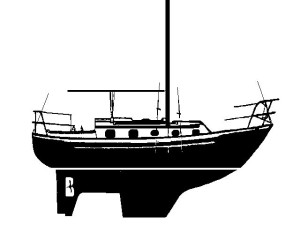Crealock 34 Cutter
34' x 6.75 Tons, Low Aspect Fin/Skeg
12-Ft. Dia. Sea Anchor
Force 8-9 Conditions
File S/M-17, obtained from Sandy and Les Bailey, Honolulu, HI. - Vessel name N'ISKU, hailing port Honolulu, Pacific Seacraft cutter designed by Bill Crealock, LOA 34' 1" x LWL 26' 2" x Beam 10' x Draft 4' 11" x 6.75 Tons - Low aspect fin keel and skeg rudder - Sea anchor: 12-ft. diameter Para-Tech on 400' x 1/2" nylon three strand with 50' of chain and 3/8" swivel - Deployed in deep water near 15° 49' N, 159° 48' W, in a gale with winds of 40-45 knots and seas of 16 feet - Vessel's bow yawed 10° - Drift was 15 miles during 14 hours at sea anchor.
N'ISKU was en route to Palmyra Atoll from Honolulu, when she ran into something akin to a Kona storm. A 12-ft. diameter Para-Tech sea anchor was then deployed, which held the bow of the yacht into the seas in a most satisfactory way. Transcript:
This was not a survival situation in the usual sense. On this passage, my wife and I had endured four successive days of 25+ knot easterly trade winds, all from ahead of the beam, with 12 to 14 foot seas from the same direction. The boat handled beautifully and we never felt threatened nor out of control, logging 150 to 160 miles per day. Unfortunately, persistent mal de mer had flattened my wife from the first day and then a streptococcal throat infection laid me low. These tribulations significantly reduced the pleasure of the sail and severely taxed our stamina. Nevertheless, we maintained our watches and did not feel it was unsafe to continue as long as conditions remained the same - which they didn't.
The wind piped up to 40 knots with higher gusts and veered a bit to the south. The seas built and became confused. The motion became most uncomfortable with a yaw component that made it very difficult for a couple of arthritic sexagenarians to get around. We then decided it was time for a little "rest and rehabilitation." We tried heaving-to under sail, but this did not prove satisfactory under those conditions. Over the side went the sea anchor and immediately our habitat became more livable. The major motion of the boat was now an almost gentle pitch, with occasional episodes of roll, but amazingly the uncomfortable yaw motion had vanished.
We used a 12 foot Para-Tech nylon parachute specifically designed as a sea anchor in a deployable storage bag. A large fender (8" x 24") served as the primary float and a smaller dinghy fender (3" x 12") at the end of 100 feet of 1/4" polypropylene was the trip line. Our rode consisted of 200 feet of three strand 1/2" nylon, 50 feet of 5/16" BBB chain and a second 200 feet of 1/2" nylon for a total of 450 feet. Swivels were used to attach the nylon rode to the anchor and to the chain (overkill perhaps). The nylon rode was led through a bow roller to cleats. Sufficient rode was released so that the bright yellow canopy of the sea anchor was visible in the crest of an oncoming swell as we were atop the crest of another wave. Three to four layers of fire hose were used for chafe protection at the roller.
We did not observe surge or shock loads on the rode. The boat always seemed to head into the wind and seas at the same angle (<10°) and did not sail about at anchor. The entire system worked perfectly, probably because of a) the length of the rode, b) the catenary induced by the chain in the middle of the rode, and c) the boat and anchor were in crests and troughs in synchrony. By morning the winds had abated to about 30 knots and backed into the east. The crew, still bruised, but very much refreshed by a night of rest, was eager to head south again.
Love the Drag Device Database? Help us to keep it free for all mariners by making a tiny donation to cover our server and maintenance costs. Thank You!
